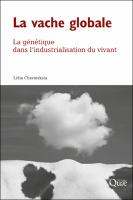La vache globale
La génétique dans l’industrialisation du vivant
Abstract
The ideal of the modern cow, a mix of nature, culture and technoscience, is embodied today by the Holstein-Frisonne, the most productive dairy breed, present throughout the world. The object of intensive selection and accelerated circulation of genetic resources, this "global cow" crystallises the tensions between science and capitalism, theory and practice, and so-called developed and developing countries. It is emblematic and gives rise to in-depth reflection on the place of calculation tools applied to living organisms and on the biological limits of industrial and commercial globalisation. This book investigates the black box of life in the complex arrangement of selection. It traces the history of the international organisation of bovine genetic evaluation and follows its actors at different levels, in Europe, the United States and in developing countries, notably South Africa. It is intended for researchers and students in the life sciences, the humanities and social sciences, as well as professionals in the world of animal husbandry and a general public interested in the place of life in industrialised and globalised agriculture.
Keywords
Africa; agriculture; cattle; economic development; economics; livestock; genetics; animal production; sociologyDOI
10.35690/978-2-7592-3449-3ISBN
9782759234486, 9782759234493, 9782759234509, 9782759234486Publisher
éditions QuaePublication date and place
2022Classification
Genetic engineering


 Download
Download